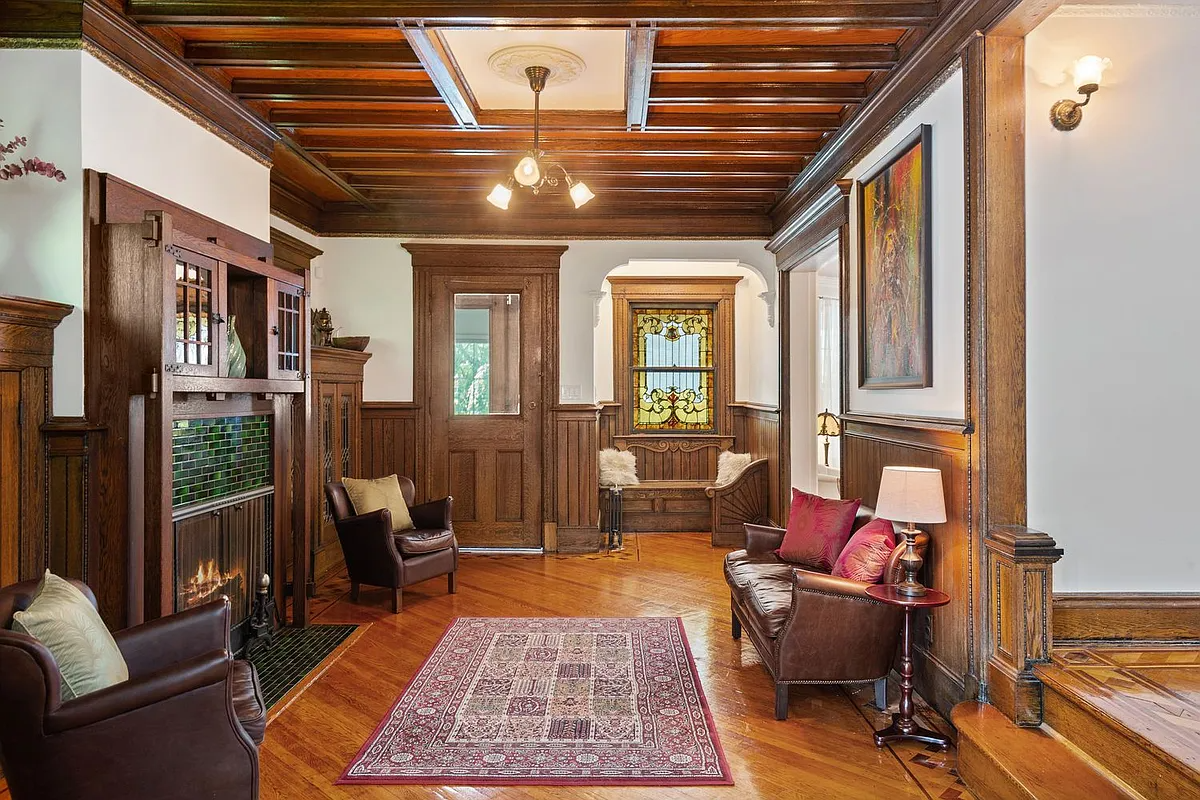Walkabout: Axel Hedman, Brooklyn Architect
It often amazes me that the architects who have contributed so much to the streetscape of our Brooklyn neighborhoods are so little known. This is especially true of someone like Axel Hedman, who in sheer terms of numbers, contributed so much. We are lucky that we have a photograph of Mr. Hedman, and that something…

A row on 3rd Street in Park Slope. Photo by Suzanne Spellen
It often amazes me that the architects who have contributed so much to the streetscape of our Brooklyn neighborhoods are so little known. This is especially true of someone like Axel Hedman, who in sheer terms of numbers, contributed so much.
We are lucky that we have a photograph of Mr. Hedman, and that something is known about his life. His great granddaughter, Barbara Hedman-Kettell, had done extensive research on his life and work, and much of the biographical work here is from that research.
Axel Hedman was born in Sweden in 1861, and emigrated to America in 1880. He became an American citizen in 1901, and lived in Brooklyn until his death in 1943. He’s listed in Brooklyn directories between 1894 and 1936.

In addition to designing under his own name, he was in partnership with Magnus Dahlander between 1894 and 1896, and with Eugene Schoen from between 1906 and 1918. Magnus Dahlander, who will be featured here at some point, was another talented Brooklyn architect, who worked in Bed-Stuy, Crown Heights, and Prospect Heights, and Eugene Schoen was featured last week as a talented furniture designer, as well as architect of synagogues and other buildings.
Whether alone or in partnership, Axel Hedman, by the end of his career, had amassed an amazing amount of work, perhaps more than any other of Brooklyn’s many architects. We can divide his work into basically three categories, row houses, flats and apartment buildings, and civic buildings. Today we’ll look at his row houses, Thursday we’ll cover the other buildings.
When it comes to Hedman’s row houses, few architects can claim to be as prolific as he was. He literally designed hundreds of row houses in the neighborhoods of Crown Heights North and South, Bedford Stuyvesant, Clinton Hill, Park Slope, Sunset Park, and Prospect Lefferts Gardens/Lefferts Manor.

Most of his work is concentrated between 1890 andd 1912. He was very influenced by the White Cities Movement, which came out of the World’s Colombian Exhibition of 1893, in Chicago. Limestone or light colored brick or stucco became the materials of choice, echoing the white buildings of the fair, with their Classical lines and detailing.
Some of Hedman’s houses of this period, and earliert are of brownstone, and he continues to use that material throughout the decade, but most of his buildings are limestone. Most are classified as Renaissance Revival.
This style is either three or four stories, usually with a three-sided or rounded bay. Some are English basement, some are the familiar tall stoops. All have carved stone ornament decorating the lintels, doorways and bays.

This ornament is often mythical creatures or faces, with popular themes being dolphins, lions, dragons, female faces or Green Men. Often they are paired with floral motifs, swags and bows, shells, cornucopia, or shields.
After identifying a few Hedman houses, its easy to think that if you’ve seen one group, you’ve seen them all. That would not be correct. True, he had a couple of formulas, and he repeated his ornamental themes a lot. So much so that identifying a Hedman house can be pretty easy, although he seems to have close imitators.
But if you look closely, he tailored his buildings to the neighborhoods and probably to potential buyers, and he added touches that make many of his groupings stand out amidst their neighbors, as the exceptional houses they are. He liked to alternate bays.

Many of his groups have a round bay next to a 3 sided bay, next to a round bay, etc in an ABABABA pattern. He liked to design very eclectic roof lines on otherwise uniform houses. His houses on Maple St, in Lefferts Manor have unique cap-like roofs with prominent cornices and Mediterranean tile hats.
A group on Union Street, in Crown Heights South features even more unusual roof lines, alternating shields and shells, the shells being originally in Mediterranean tile. His English basement row on Ocean Ave, newly landmarked, is set back further into the lots, than many of his other groups.
This allows for plantings that can extend the garden line from the owners’ front doors across the park for acres of green. The then puts a private pathway in front of the stairs which runs across the row. Similar groups in Crown Heights North and South and Park Slope don’t have the deep setback, or the private walk, but have similar porch areas, and similar trim, yet different bays.

In the interiors, as well, Hedman built according to the neighborhood and income of his potential buyers. Many of his houses have rich Colonial Revival details, with Classical columns and pediments, popular with the Classical traditions of the White Cities and Colonial movements.
Some have distinctly Arts and Crafts/Craftsman details, featuring simpler tiles fireplaces and mantles, and dining rooms with tall wainscot paneling, plate rails and coffered ceilings. Original fixtures often include Medieval baronial sconces or chandeliers, and always fine parquet floors and built-ins.
Renaissance Revival homes usually have a more open floor plan, with large entrances often featuring sets of French doors, which allow light to pass through the house, or wide openings set flanked by columns. The rooms are usually large, and wide.

My Flickr page shows many examples of the row houses Axel Hedman is known for. You can’t help but notice the similarities, but look carefully at the details, they make his homes a delight.
On Thursday, I’ll introduce you to his multiple-unit buildings, as well as his other work. His apartment buildings are very different, from his houses, and from each other. I think the talent of Axel Hedman is best expressed in his apartment buildings. Bigger canvases, bigger ideas.
Axel Hedman designed some of his best row houses in Park Slope, with limestone rows on PPW, 3rd, 6th and Union Streets, as well as Polhemus Place. Some of the houses on Polhemus are brownstones, not limestones.

Unfortunately, due to ongoing computer problems, I don’t have access to very many of my Park Slope pix, as well as many other neighborhood photos, which would have shown more variety in his design. I’ll post these on Thursday, with his apartment buildings. Sorry for the inconvenience. I now have access to a new computer.
[Photos by Suzanne Spellen]





The designtation report for Brooklyn Heights is the worst of any district. It has absolutely no detail. By contrast, the report for Greenwich Village, which was the second designated historc district, is totally detailed and lists every building. The Greenwich Village Society had its act together and was evidently willing to spend a few dollars.
For historical information on the architecture of Brooklyn Heights one has to rely on the old chestnut “Old Brooklyn Heights” by Clay Lancaster. Written with true WASP rigour, the book does not touch on any property less than 100 years old and since the book was written in 1961, that means that nothing built after 1861 is included. Useful, huh?
HOWEVER, Brooklyn historian Frances Morrone is working on a book that explores the post-1861 buildings in the Heights, including the early twentieth century houses such as 24 and 26 Remsen Street that look to me like they came from the drawing board of White City architects such as Helmle & Huberty or CPH Gilbert.
bxgrl – I don’t think so. Here is link to LPC designation report, 1965.
http://bit.ly/d7hLxU
MM- I might be mistaken but i think the BH designation in the 50’s was a federal historic district one, not LPC. As I said, I could be wrong (Wouldn’t be the first time!)
MM – thanks for the reply. I did check DOB and nothing there. Some interesting facts about 24 and 26 Remsen. Circa 1890 both lots (24 vacant and 26 having a 2-story “structure” set 15 feet off the sidewalk and attached to 28 Remsen) were each 25 feet wide and were the last two lots on the block to be re-developed at that time. When 26 Remsen was purchased by a woman in 1894 it’s lot width was reduced to 20 feet, and therefore 24 lot width increased to 30 feet. Two years later, 1896, a different woman was granted a building permit to build 26 Remsen. Do you agree that a woman purchasing a lot and applying for a building permit would be a rarity at that time?
Interesting article and great pictures. Readers might also be interested in two posts on Hedman in the Brooklyn Collection’s blog, Brooklynology:
http://tinyurl.com/yd8ezuh
and
http://tinyurl.com/ykwy23a
Ms Hedman-Kettell worked closely with BPL librarians in identifying Hedman-designed buildings and uncovering biographical information. She graciously donated to the Brooklyn Collection a copy of the information she compiled and a set of photographs taken during her family building tour. These can be viewed by appointment during the Collection’s open hours.
Interesting, who knew?
He looks a little like Captain Sullenberger, the hero of the Hudson jet landing.
Hmmmm, Donald. I don’t think so. It’s a Romanesque Revival home, and interestingly enough, if you told me it was a Montrose Morris, I would have to believe you, there are a lot of his elements in there. But I don’t think it’s his either. I looked it up in the AIA guide, but it doesn’t list the architect, as you probably know. I think it’s a bit too florid for Axel, and he really wasn’t too much of an arch user, I find.
Brooklyn Height’s honor as the first neighborhood to be designated in the 1960’s is a great thing, but unfortunately, that meant that the newly appointed Landmarks Preservation Commission did not have their systems down, and did not do individual reports on houses, so their landmarking report is about 5 pages. When we got designated in Crown Heights North, our report was over 300 pages. I’m sure this house was designed by someone well known, and significant. I wish I knew who it was. Have you tried going to the DOB and pulling the file? The architect may be listed, or the original blueprints may be on file.
Bxgrl, Monty is better known for his darker brick and brownstone architecture in the Romanesque Revival style, which came before Renaissance Revival by about 10 years. It’s amazing how radically styles can change, especially in buildings, which are not exactly a short process to design or put up. Monty’s excursions into Romanesque Revival are much more ponderous, as he was specifically designing for his wealthy PPW clients, whereas Hedman was designing on spec for people who had money, and were upper middle class, but nowhere as rich as Morris’ clients, who were captains of industry and finance.
Thank you Pigeon. That was taken with a 15 mm ultra wide angle lens on a Leica. The camera had to be tripod-mounted and carefully leveled to avoid the distortion inherent in such extreme WA lenses. Since we have 4days/week alternate side parking in Lefferts Manor the car-free part was easy.